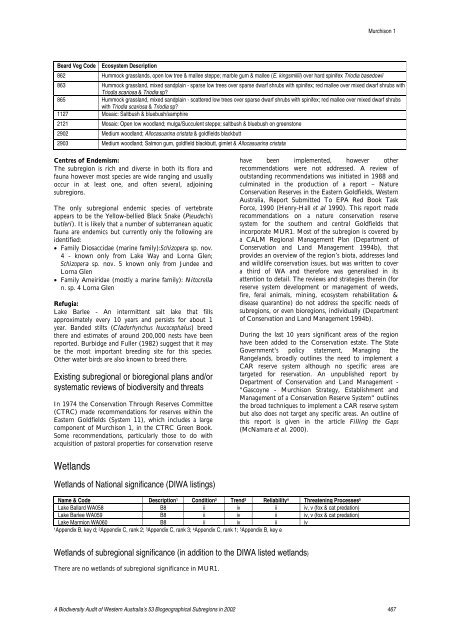Murchison 1 (MUR1 – East Murchison subregion) - Department of ...
Murchison 1 (MUR1 – East Murchison subregion) - Department of ...
Murchison 1 (MUR1 – East Murchison subregion) - Department of ...
Create successful ePaper yourself
Turn your PDF publications into a flip-book with our unique Google optimized e-Paper software.
<strong>Murchison</strong> 1Beard Veg Code Ecosystem Description862 Hummock grasslands, open low tree & mallee steppe; marble gum & mallee (E. kingsmillii) over hard spinifex Triodia basedowii863 Hummock grassland, mixed sandplain - sparse low trees over sparse dwarf shrubs with spinifex; red mallee over mixed dwarf shrubs withTriodia scariosa & Triodia sp?865 Hummock grassland, mixed sandplain - scattered low trees over sparse dwarf shrubs with spinifex; red mallee over mixed dwarf shrubswith Triodia scariosa & Triodia sp?1127 Mosaic: Saltbush & bluebush/samphire2121 Mosaic: Open low woodland; mulga/Succulent steppe; saltbush & bluebush on greenstone2902 Medium woodland; Allocasuarina cristata & goldfields blackbutt2903 Medium woodland; Salmon gum, goldfield blackbutt, gimlet & Allocasuarina cristataCentres <strong>of</strong> Endemism:The <strong>subregion</strong> is rich and diverse in both its flora andfauna however most species are wide ranging and usuallyoccur in at least one, and <strong>of</strong>ten several, adjoining<strong>subregion</strong>s.The only <strong>subregion</strong>al endemic species <strong>of</strong> vertebrateappears to be the Yellow-bellied Black Snake (Pseudechisbutleri). It is likely that a number <strong>of</strong> subterranean aquaticfauna are endemics but currently only the following areidentified:• Family Diosaccidae (marine family):Schizopera sp. nov.4 - known only from Lake Way and Lorna Glen;Schizopera sp. nov. 5 known only from Jundee andLorna Glen• Family Ameiridae (mostly a marine family): Nitocrellan. sp. 4 Lorna GlenRefugia:Lake Barlee - An intermittent salt lake that fillsapproximately every 10 years and persists for about 1year. Banded stilts (Cladorhynchus leucocephalus) breedthere and estimates <strong>of</strong> around 200,000 nests have beenreported. Burbidge and Fuller (1982) suggest that it maybe the most important breeding site for this species.Other water birds are also known to breed there.Existing <strong>subregion</strong>al or bioregional plans and/orsystematic reviews <strong>of</strong> biodiversity and threatsIn 1974 the Conservation Through Reserves Committee(CTRC) made recommendations for reserves within the<strong>East</strong>ern Goldfields (System 11), which includes a largecomponent <strong>of</strong> <strong>Murchison</strong> 1, in the CTRC Green Book.Some recommendations, particularly those to do withacquisition <strong>of</strong> pastoral properties for conservation reservehave been implemented, however otherrecommendations were not addressed. A review <strong>of</strong>outstanding recommendations was initiated in 1988 andculminated in the production <strong>of</strong> a report <strong>–</strong> NatureConservation Reserves in the <strong>East</strong>ern Goldfields, WesternAustralia, Report Submitted To EPA Red Book TaskForce, 1990 (Henry-Hall et al 1990). This report maderecommendations on a nature conservation reservesystem for the southern and central Goldfields thatincorporate <strong>MUR1</strong>. Most <strong>of</strong> the <strong>subregion</strong> is covered bya CALM Regional Management Plan (<strong>Department</strong> <strong>of</strong>Conservation and Land Management 1994b), thatprovides an overview <strong>of</strong> the region’s biota, addresses landand wildlife conservation issues, but was written to covera third <strong>of</strong> WA and therefore was generalised in itsattention to detail. The reviews and strategies therein (forreserve system development or management <strong>of</strong> weeds,fire, feral animals, mining, ecosystem rehabilitation &disease quarantine) do not address the specific needs <strong>of</strong><strong>subregion</strong>s, or even bioregions, individually (<strong>Department</strong><strong>of</strong> Conservation and Land Management 1994b).During the last 10 years significant areas <strong>of</strong> the regionhave been added to the Conservation estate. The StateGovernment's policy statement, Managing theRangelands, broadly outlines the need to implement aCAR reserve system although no specific areas aretargeted for reservation. An unpublished report by<strong>Department</strong> <strong>of</strong> Conservation and Land Management -"Gascoyne - <strong>Murchison</strong> Strategy, Establishment andManagement <strong>of</strong> a Conservation Reserve System" outlinesthe broad techniques to implement a CAR reserve systembut also does not target any specific areas. An outline <strong>of</strong>this report is given in the article Filling the Gaps(McNamara et al. 2000).WetlandsWetlands <strong>of</strong> National significance (DIWA listings)Name & Code Description 1 Condition 2 Trend 3 Reliability 4 Threatening Processes 5Lake Ballard WA058 B8 ii iv ii iv, v (fox & cat predation)Lake Barlee WA059 B8 ii iv ii iv, v (fox & cat predation)Lake Marmion WA060 B8 ii iv ii iv1Appendix B, key d; 2 Appendix C, rank 2; 3 Appendix C, rank 3; 4 Appendix C, rank 1; 5 Appendix B, key eWetlands <strong>of</strong> <strong>subregion</strong>al significance (in addition to the DIWA listed wetlands)There are no wetlands <strong>of</strong> <strong>subregion</strong>al significance in <strong>MUR1</strong>.A Biodiversity Audit <strong>of</strong> Western Australia’s 53 Biogeographical Subregions in 2002 467
















